20 places around Buzzards Bay to discover a vernal pool this spring
With spring just around the corner, everyone is on the lookout for signs of the season. As spring peepers begin chirping and ospreys start nesting, there’s one sign of spring we find particularly special – vernal pools. What’s a vernal pool, and where can you see one? Keep reading to find out!
What is a vernal pool?
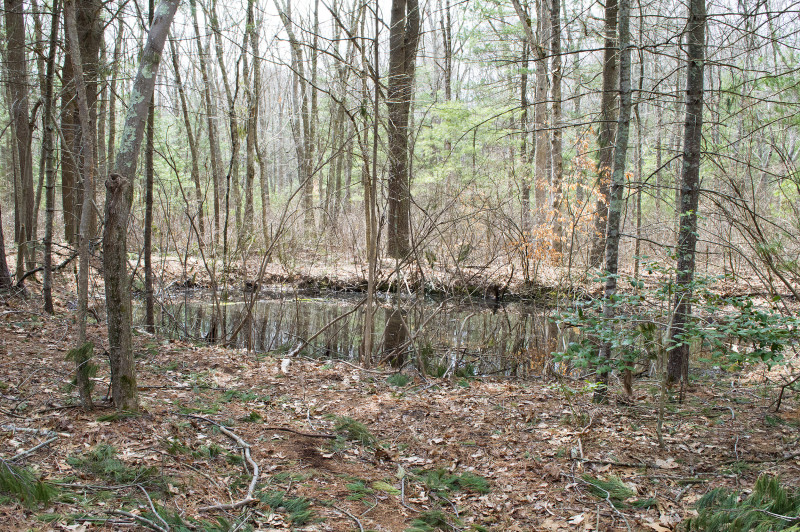
A vernal pool, like this one at Flora B. Peirce Nature Trail in New Bedford, is a temporary wetland that forms in a shallow depression in the woods in spring.
Vernal pools are small ponds that appear, like clockwork, in shallow depressions in certain woods every spring. Filled with rain and melted snow, vernal pools eventually dry out in the heat of summer. That’s part of what makes them so special to see in spring.
Because of their temporary nature, vernal pools aren’t home to fish. Instead, amphibians like wood frogs and spotted salamanders lay their eggs here, as do some insects. These particular species have evolved to lay their eggs in vernal pools, and can’t breed anywhere else.
Vernal pools are fascinating places, but they’re also extremely sensitive and best viewed from solid ground. Massachusetts has strong regulations that protect vernal pools, but we all need to do our part to keep these special habitats safe.
Where can I view a vernal pool around Buzzards Bay?
There are dozens of vernal pools in the Buzzards Bay watershed – from Westport all the way to Woods Hole. You can see where all the certified vernal pools in Massachusetts are located on this interactive map.
To make it easy for you, we’ve rounded up 20 spots where you can take a walk this spring and see a vernal pool. But before you go, remember – vernal pools are delicate habitats. Please enjoy the view from a distance, and keep dogs and children away from the water to protect eggs and small species.
1. Westport Woods Conservation Park (Westport)
Westport Woods is a brand-new Westport Land Conservation Trust property is full of varied habitats to explore! One you can only find during the spring is the vernal pool on the north side of the trail network. This peaceful spot is easy to find: just follow the signs along the central trail, which starts behind the old gymnasium buildings.
2. Old Harbor Wildlife Refuge (Westport)
There are several vernal pools throughout the forested wetlands at Old Harbor Wildlife Refuge. The easiest to find is a state-certified pool at the north side of the property, along the blue trail. However, if you look and listen while you walk through the trees, calling frogs will likely lead you to more!
3. Dunham’s Brook Conservation Area (Westport)
Follow the easternmost trail at Dunham’s Brook, a Westport Land Conservation Trust property, to the edge of an extensive forested wetland/vernal pool community. Visit near dusk, and you’ll be treated to a loud spring chorus of mating frogs.
4. Copicut Woods (Fall River)
The Trustees’ Copicut Woods is part of the Southeastern Massachusetts Bioreserve. This 13,600-acre area along the Fall River/Freetown border is full of wetlands. As you walk the three miles of trails at Copicut Woods, you’ll pass vernal pools and a special cedar swamp.
5. Parsons Reserve (Dartmouth)
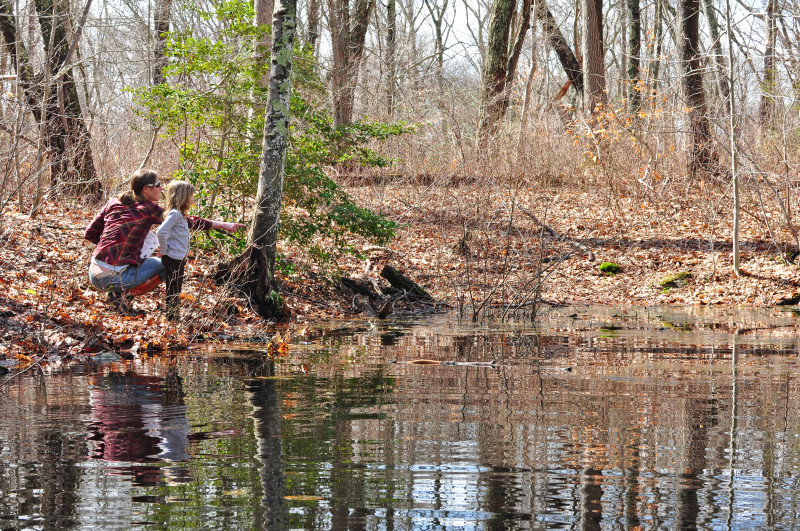
Discover a spring vernal pool at Parsons Reserve in Dartmouth.
The Dartmouth Natural Resources Trust’s Parsons Reserve is home to a large vernal pool that thrives with many species in spring. Spot it from the Green Trail, in the back corner of the property.
6. Demarest Lloyd State Park (Dartmouth)
From the northwest corner of the parking lot at Demarest Lloyd State Park, a trail leads through the salt marsh and brings visitors to a beautiful vernal pool in the woods.
7. Flora B. Peirce Nature Trail (New Bedford)
The city-owned Flora B. Peirce Nature Trail is one of New Bedford’s best-kept secrets. The vernal pool here is just one of the surprises hidden in this natural area in the North End.
8. Little Bay Conservation Area (Fairhaven)
Though you might normally think of rich salt marshes and great fishing when you think of Little Bay Conservation Area, this town-protected area is also home to no fewer than three certified vernal pools — all located just off the Phoenix Bike trail extension. The easiest to find is just before the wind turbine, at the intersection of the bike trail and the dirt road.
9. Shaw Farm Trail & Nasketucket Bay State Reservation (Fairhaven/Mattapoisett)
The Coalition’s Shaw Farm Trail connects the local bike path with Nasketucket Bay State Reservation, where there are two certified vernal pools. Together, these trails offer a great spring day of exploration through the woods to the shores of Nasketucket Bay.
10. Old Aucoot District (Mattapoisett)
It takes a bit of a hike to reach the vernal pool in the Old Aucoot District, but your discovery is worth the walk. The vernal pool is on the far side of the Hiller Loop, which will take you past blueberry fields and through peaceful woods. Stop in at this Mattapoisett Land Trust property off Aucoot Road for a springtime visit.
11. Tinkhamtown Woodlands (Mattapoisett)
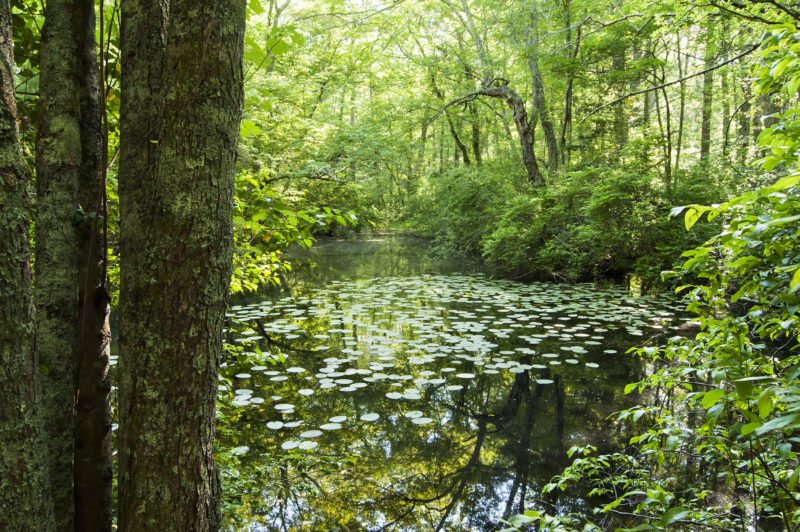
See a large vernal pool up close at the Mattapoisett Land Trust’s Woodcock Preserve, which borders Tinkhamtown Woodlands.
Discover one of the area’s largest vernal pools, ringing with calling frogs, amongst a patchwork of rich wetlands within Woodcock Preserve. This adjoining section of Tinkhamtown Woodlands was protected by the Mattapoisett Land Trust. This vernal pool is easily accessible from the entrance along Long Plain Road.
12. Shoolman Preserve (Rochester)
Just up the road for Tinkhamtown Woodlands, you can view another vernal pool just minutes down the trail at Shoolman Preserve. Though it might look a bit like a trickling steam, this long, narrow pool is a springtime home for creatures that are unique to a vernal pool, including wood frogs and fairy shrimp.
13. Doggetts Brook Recreational Area (Rochester)
Just behind the Dexter Lane ball fields, explorers can enter Doggetts Brook Recreational Area. Look for a large vernal pool at the back of the field where the loop trail begins.
14. Rounseville II Preserve (Rochester)
On the other side of Route 105 from Doggetts Brook Recreational Area, explore the Wildlands Trust’s Rounseville II Preserve. Look for the vernal pool at the base of the hill in the property’s back corner.
15. Hartley Reservoir Wildlife Management Area (Rochester)
Take in scenic water views on a relaxing hike to the vernal pool at Hartley Reservoir. This complex of seven ponds is part of the larger Rochester Wildlife Management Area, a hotspot of vernal pools — but because it’s not mapped, the WMA as a whole can be difficult to explore. With its easy-to-follow loop trail, Hartley offers an accessible way to discover these woodlands’ spring life. You’ll find the vernal pool on the western side of the loop, between the trail and the water’s edge.
16. Myles Standish State Forest (Carver/Plymouth)
Myles Standish State Forest is known for its trees and cranberry bogs, but there are vernal pools here, too! Look for one of several certified vernal pools around Barretts and East Head ponds.
17. Four Ponds Conservation Area – Bourne Town Forest (Bourne)
Vernal pools and wetlands are common in the woods at Four Ponds Conservation Area, which sits next to Bourne Town Forest. Explore the loop trails here, and listen for frogs to help tell you where the vernal pools are.
18. Breivogel Ponds Conservation Area (Falmouth)
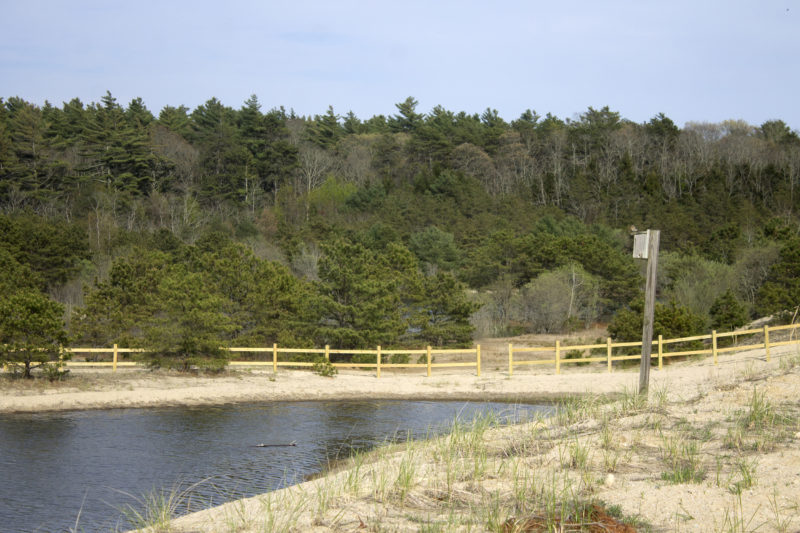
Bird boxes overlook Breivogel Ponds’ vernal pools, which on rainy years can combine to form one large pond.
This fascinating Falmouth preserve features not just one vernal pool, but five! The shallow seasonal ponds at Breivogel Ponds Conservation Area were created by The 300 Committee to encourage springtime life to return to this former gravel mine, now being restored to a sandplain grassland — one of the rarest habitats worldwide.
19. Goodwill Park/Long Pond (Falmouth)
Goodwill Park is a gateway to Long Pond and Falmouth Town Forest, part of Falmouth’s extensive glacial moraine trail. Look for several vernal pools along the trails that lead from Goodwill Park toward the pond.
20. Beebe Woods (Falmouth)
As you explore Beebe Woods’ network of trails, you’re sure to find ponds and pastures, but there are vernal pools here, too! Look for one along the trail in the property’s northwest corner.
What types of species live in vernal pools?
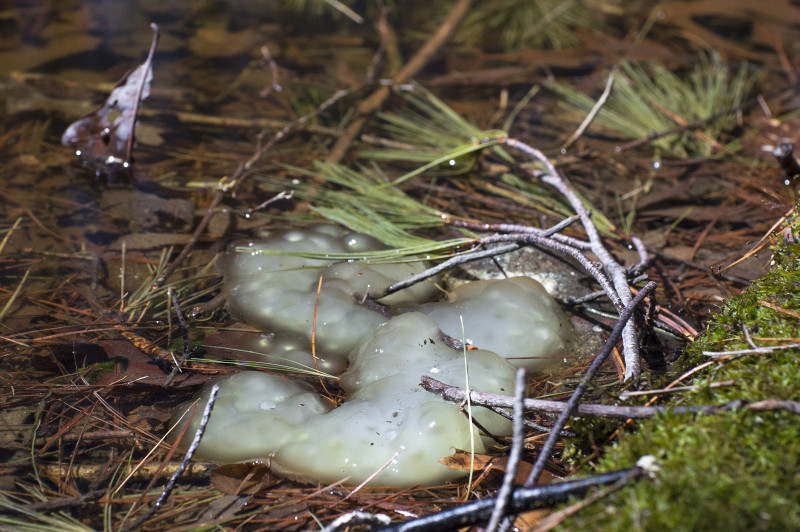
Frogs and salamanders use vernal pools across Buzzards Bay to breed. They lay their eggs, which look like gelatinous masses, in this delicate ecosystem.
Once you’ve spotted a vernal pool, you might be wondering what’s happening beneath the surface. Amphibians like woods frogs and spotted salamanders gather at vernal pools during early spring rain storms to breed in these unique little wetlands. In vernal pools, their jelly-like egg masses are safe from fish and other large predators. Once the eggs hatch, young frogs and salamanders grow up and depart before the pool dries up. You might think of vernal pools as amphibian elementary school!
Here are a few species that are probably living in a vernal pool you visit:
- Spotted salamanders: These yellow-spotted salamanders – which can grow to nearly ten inches long! – will stay in a vernal pool for just a few days to mate and lay their eggs before returning to their burrows. Light brown hatchlings will emerge a month or two later.
- Wood frogs: Black-“masked” wood frogs are another species that breed exclusively in vernal pools. In late winter and early spring, wood frogs gather in huge numbers at vernal pools and search for a mate.
- Fairy shrimp: These tiny crustaceans are one of the first vernal pool species to hatch – they’ve even been seen swimming under the ice in frozen vernal pools! In addition to being cool little dudes, fairy shrimp provide an important source of food for other species that use vernal pools.
- Caddisfly larvae: Caddisflies are moth-like insects, but the larvae are aquatic. You can sometimes find caddisfly larvae hidden in a cocoon of spiky pine needles in vernal pools.
- Red-spotted newts: Red-spotted newts don’t require vernal pools, but they will use them if they’re there. You might see small brown newt larvae or greenish-colored adults swimming in a vernal pool. Nearby, look for land-dwelling juveniles, which are an unmistakable bright orange color.
- Spring peepers: Like the red-spotted newt, spring peepers don’t need vernal pools, but they like them. These tiny frogs hibernate all winter and emerge in early spring. Listening to their calls ring through the woods on a cool, wet March evening is a true delight for winter-weary outdoor explorers.